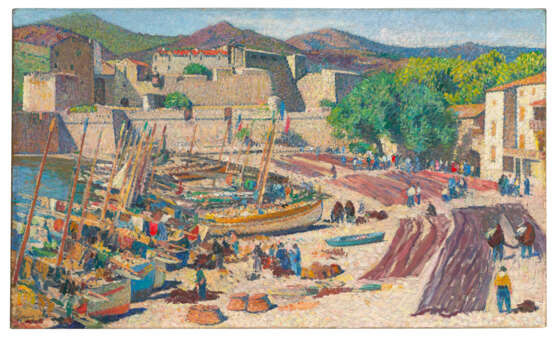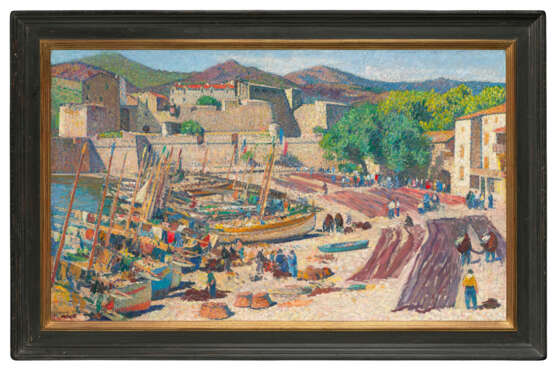ID 1400189
Лот 338 | Henri Martin (1860-1943)
Оценочная стоимость
€ 250 000 – 350 000
Port de Collioure le 14 juillet, séchage des filets sur la grève
signé 'Henri Martin' (en bas à gauche)
huile sur toile
75 x 125.5 cm.
Peint entre 1923 et 1942
signed 'Henri Martin' (lower left)
oil on canvas
29 ½ x 49 3/8 in.
Painted between 1923 and 1942
Provenance
Atelier de l’artiste.
Collection particulière, France (par descendance).
Galerie Alexis Pentcheff, Marseille (acquis auprès de celle-ci en 2017).
Vente, Hôtel des Ventes de Monte-Carlo, Monte-Carlo, 19 janvier 2023, lot 8.
Acquis au cours de cette vente par le propriétaire actuel.
Further details
Cette œuvre sera incluse au catalogue raisonné de l'œuvre d'Henri Martin actuellement en préparation par Marie-Anne Destrebecq-Martin.
« Dans un tournant de la côte, au débouché d'une vallée, parsemée de forts, de jardins et de criques pittoresques... voici l'agréable ville de Collioure. La perspective est charmante » (V.-E. Ardouin-Dumazet cité dans J. D. Herbert, Fauve Painting, The Making of Cultural Politics, New Haven, 1992, p. 92).
Collioure, village du Sud de la France ayant inspiré de nombreux artistes tels que Matisse, Bonnard ou encore Derain, son port a fait l’objet de multiples interprétations parmi lesquelles on peut compter celles d’Henri Martin.
Figure du néo-impressionnisme, Martin, captivé par les décors méditerranéens, apporte un aspect vibrant et lumineux au village de Collioure par les touches de couleurs vives et la précision de son pointillisme. Lui-même propriétaire d’une maison colliourencque, il tombe sous le charme de l’architecture prédominante de ses fortifications et de son phare datant de la Rome antique.
Si ce lieu a suscité l’exaltation de l’artiste, c’est certainement en raison du contraste de paysages offrant un panorama où se dessinent le relief verdoyant des montagnes bordées par une mer méditerranée scintillante. La lumière douce partagée entre les touches de couleurs représentant la mer, la nature et les activités des pêcheurs venant rencontrer les ocres des édifices et des montagnes offrent un parfait équilibre harmonieux et chatoyant.
C’est avec un mélange d’activités humaines réalisées dans un lieu chargé d’histoire qu’Henri Martin fait du village un témoin notoire après avoir traversé le Moyen-Age ou encore les Royaume d’Aragon, de Majorque, de France et d’Espagne. Le village fini par être rattaché à la France à la fin du XVIIème siècle lui permettant de se détacher de son passé militaire pour laisser place aux activités des pêcheurs et en faire un lieu de vie que Martin a choisi de représenter à plusieurs reprises.
"Located at the corner of the coastline, at the end of a valley, with forts, gardens and coves scattered all around in a picturesque way, lies the pleasant town of Collioure. The prospect is charming" (V.-E. Ardouin-Dumazet quoted in J. D. Herbert, Fauve Painting, The Making of Cultural Politics, New Haven, 1992, p. 92).
Collioure, a village in the south of France, has inspired artists such as Matisse, Bonnard and Derain. Its port in particular has been the focus of many painterly interpretations including those by Henri Martin.
A leading figure in Neo-Impressionism, Martin, captivated by the Mediterranean scenery, brought a vibrant, luminous aspect to the village of Collioure with his touches of vivid colour and the precision of his pointillism. He had a house of his own in Collioure, and he was mesmerized by the predominant architecture of the town’s fortifications and lighthouse, that datefrom Ancient Rome.
What may have inspired the artist is most probably the contrasting landscapes offering a panorama where the mountains’ green relief is lined withthe glistening Mediterranean sea. The soft light, shared between the splashes of colour representing the sea, nature and the fishermen’s activities, confronts the ochre of the buildings and mountains, creating a perfect, harmonious, shimmering balance.
With a mixture of human activities carried out in a place steeped in history, Henri Martin made the village a notorious witness to the Middle Ages as well as to the kingdoms of Aragon, Majorca, France and Spain. The village eventually became part of France at the end of the 17th century, allowing it to move away from its military past and give way to the local activities of fishermen, making it a comfortable place to live, that Martin chose to depict on several occasions.
| Автор: | Анри Мартен (1860 - 1943) |
|---|---|
| Техника исполнения: | Масло на холсте |
| Место происхождения: | Западная Европа, Франция, Европа |
| Категория аукционного дома: | Картины, Акварели, Рисунки, Картины |
| Автор: | Анри Мартен (1860 - 1943) |
|---|---|
| Техника исполнения: | Масло на холсте |
| Место происхождения: | Западная Европа, Франция, Европа |
| Категория аукционного дома: | Картины, Акварели, Рисунки, Картины |
| Адрес торгов |
CHRISTIE'S 8 King Street, St. James's SW1Y 6QT London Великобритания | |
|---|---|---|
| Предосмотр |
| |
| Телефон | +44 (0)20 7839 9060 | |
| Комиссия | see on Website | |
| Условия использования | Условия использования |















